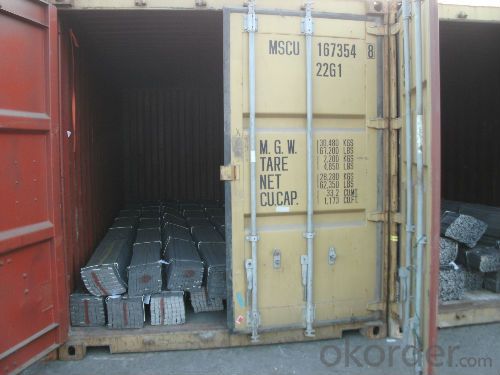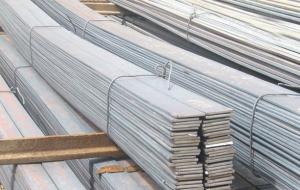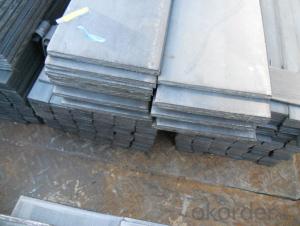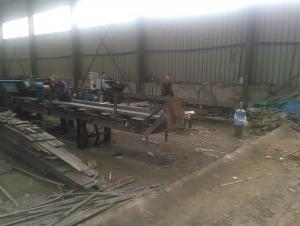Flat Iron Bars Slitting by Cutting Machine
- Loading Port:
- China Main Port
- Payment Terms:
- TT or LC
- Min Order Qty:
- 100 m.t.
- Supply Capability:
- 10000 m.t./month
OKorder Service Pledge
OKorder Financial Service
You Might Also Like
OKorder is offering Flat Iron Bars Slitting by Cutting Machine at great prices with worldwide shipping. Our supplier is a world-class manufacturer of steel, with our products utilized the world over. OKorder annually supplies products to African, South American and Asian markets. We provide quotations within 24 hours of receiving an inquiry and guarantee competitive prices.
Product Applications:
Flat Iron Bars Slitting by Cutting Machine are ideal for structural applications and are widely used in the construction of buildings and bridges, and the manufacturing, petrochemical, and transportation industries.
Product Advantages:
OKorder's Flat Iron Bars Slitting by Cutting Machine are durable, strong, and wide variety of sizes.
Main Product Features:
· Premium quality
· Prompt delivery & seaworthy packing (30 days after receiving deposit)
· Can be recycled and reused
· Mill test certification
· Professional Service
· Competitive pricing
Product Specifications:
Manufacture: slited
Slitting precision (width) : 0.5 mm or less
Raw material: Q235B, Q345B, Q235-1 b
crosscutting precision (length) : 2 mm or less
Processing: the thickness of 2.0-16 mm;
Shear length: 2000 mm above
Wide degree: 15-1250 - mm;
Leveling precision: 1-2 MM square
Packaging: Export packing, nude packing, bundled
FAQ:
Q1: How many tons of steel products could be loaded in containers?
A1: Usually the steel products are delivered by bulk vessel because of the large quantity and the freight. However, there are no bulk vessel enter some seaports so that we have to deliver the cargo by containers. The 6m steel product can be loaded in 20FT container, but the quantity is changed according to the size, usually from 18tons to 25tons.
Q2: How do we guarantee the quality of our products?
A2: We have established an advanced quality management system which conducts strict quality tests at every step, from raw materials to the final product. At the same time, we provide extensive follow-up service assurances as required.
Q3: How soon can we receive the product after purchase?
A3: Within three days of placing an order, we will arrange production. The normal sizes with the normal grade can be produced within one month. The specific shipping date is dependent upon international and government factors, the delivery to international main port about 45-60days.
Images:


- Q: Can steel flat bars be used for making molds or dies?
- Yes, steel flat bars can be used for making molds or dies. Steel flat bars have excellent strength and durability, making them suitable for creating molds or dies used in various industrial applications.
- Q: What are the different surface finishes for stainless steel flat bars?
- There are several different surface finishes for stainless steel flat bars, including mill finish, brushed finish, mirror finish, and satin finish.
- Q: How do you protect steel flat bars from UV radiation or sun damage?
- There are several ways to protect steel flat bars from UV radiation or sun damage. Firstly, one can apply a protective coating to the surface of the bars. A high-quality paint formulated for outdoor use, with UV-resistant properties, is a common option. This will prevent fading or discoloration of the bars. Another effective method is to use a clear sealant or varnish with UV inhibitors. These products create a barrier on the steel's surface, blocking UV radiation and reducing the risk of sun damage. It is important to choose a sealant designed for metal surfaces to ensure maximum effectiveness. In addition to these measures, regular cleaning and maintenance of the steel bars is vital. This involves removing any dirt, dust, or debris that can intensify UV damage. Regular inspections should also be conducted to identify signs of corrosion or deterioration, as these weaken the steel and make it more susceptible to UV damage. Lastly, if the steel bars are exposed to direct sunlight for extended periods, providing shade or cover is recommended. Awnings, canopies, or other protective structures can be used to block or diffuse sunlight, reducing the intensity of UV exposure. By implementing these protective measures, the steel flat bars can be safeguarded against UV radiation and sun damage, preserving their longevity and structural integrity.
- Q: Can steel flat bars be threaded?
- Negative, threading is not possible for steel flat bars. Threading involves the creation of helical grooves on a material surface to enable the attachment of fasteners or other elements. Steel flat bars, as their name implies, possess a smooth surface and lack the essential characteristics required for threading. Nonetheless, in cases where threaded connections are necessary, alternative steel products like threaded rods or pipes can be employed.
- Q: Can steel flat bars be used for making furniture frames or supports?
- Yes, steel flat bars can definitely be used for making furniture frames or supports. Steel is a versatile and durable material that offers excellent strength and stability, making it ideal for furniture construction. Steel flat bars provide a strong foundation and structural integrity to furniture frames or supports, ensuring longevity and stability. Additionally, steel can be easily shaped and welded, allowing for flexibility in design and customization. It is commonly used in the construction of various furniture pieces such as tables, chairs, shelving units, and bed frames. Overall, steel flat bars are a reliable choice for furniture frames or supports, providing a sturdy and long-lasting solution.
- Q: How do you store steel flat bars to prevent damage?
- To store steel flat bars and prevent damage, there are a few key steps you can follow: 1. Choose a suitable storage area: Ensure the storage area is clean, dry, and well-ventilated. Avoid storing the flat bars in areas prone to moisture or extreme temperature fluctuations. If possible, designate a specific area for storing steel flat bars to minimize the risk of damage. 2. Use proper stacking techniques: When storing multiple steel flat bars, stack them horizontally on a flat surface. Make sure to align the bars properly, ensuring they are parallel to each other. Avoid stacking them too high to prevent excessive weight and potential bending or warping. 3. Employ appropriate supports: Place timber or rubber supports between the layers of stacked flat bars. These supports prevent direct contact between the bars, reducing the risk of scratches or surface damage. Using supports also helps distribute the weight evenly and maintain the flatness of the bars. 4. Protect against moisture: Moisture can cause rust or corrosion on steel flat bars. To prevent this, consider using moisture-absorbing materials such as silica gel packets or desiccants in the storage area. Additionally, cover the stacked bars with a plastic sheet or tarp to shield them from moisture and humidity. 5. Keep an organized inventory: Maintain a proper record of the stored steel flat bars, including their dimensions, grades, and quantities. Regularly inspect the inventory to identify any signs of damage, rust, or deformation. This will enable you to address any issues promptly and prevent further damage. 6. Handling and transportation precautions: When moving or transporting steel flat bars, use appropriate lifting equipment such as forklifts or cranes to avoid excessive stress on the bars. Always handle them with care and avoid dropping or dragging them, as this can cause dents, scratches, or deformation. By following these guidelines, you can ensure the proper storage of steel flat bars and minimize the risk of damage, preserving their quality and integrity.
- Q: What is the standard thickness of a steel flat bar?
- The specific application and industry standards are what determine the standard thickness of a steel flat bar, which can vary. Nevertheless, commonly found steel flat bars usually come in thicknesses ranging from 1/8 inch to 1 inch. It's worth mentioning that custom sizes and thicknesses are also offered to fulfill specific requirements.
- Q: Are steel flat bars prone to corrosion?
- Corrosion is a common issue for steel flat bars. Being primarily composed of iron, steel can undergo a reaction with moisture or specific chemicals, resulting in the formation of iron oxide, commonly known as rust. This chemical process is referred to as corrosion. Although steel is generally more resistant to corrosion in comparison to metals like aluminum, it is not entirely impervious. The rate at which corrosion occurs can be influenced by various factors, including the quality of the steel, environmental conditions, and the presence of corrosive agents. To reduce the risk of corrosion, steel flat bars can be coated with galvanization or paint, or manufactured using corrosion-resistant alloys like stainless steel. Consistent maintenance and proper handling practices are also essential in preventing and minimizing corrosion.
- Q: What are the different types of steel used in manufacturing flat bars?
- There are several different types of steel that are commonly used in the manufacturing of flat bars. Some of the most common types include: 1. Mild Steel: This is the most common type of steel used in manufacturing flat bars. It is a low carbon steel that is relatively inexpensive and easy to work with. Mild steel flat bars have good weldability and are commonly used in construction, fabrication, and general manufacturing applications. 2. Stainless Steel: Stainless steel flat bars are made from an alloy of steel and chromium, which provides excellent corrosion resistance. It is commonly used in food processing, chemical, and medical industries where hygiene and resistance to corrosion are crucial. 3. Tool Steel: Tool steel flat bars are often used in the manufacturing of cutting tools, dies, and molds. They have high hardness, wear resistance, and toughness, making them suitable for applications that require high strength and durability. 4. Alloy Steel: Alloy steel flat bars are made by adding additional elements such as manganese, chromium, or nickel to improve their mechanical properties. They are commonly used in automotive, aerospace, and machinery industries where high strength and toughness are required. 5. Carbon Steel: Carbon steel flat bars are made from iron and carbon, with a carbon content typically ranging from 0.05% to 2.1%. They are versatile and widely used in various manufacturing applications due to their excellent strength and affordability. It's important to note that these are just a few examples of the types of steel used in manufacturing flat bars. Each type has its own unique properties and advantages, and the choice of steel depends on the specific requirements of the application.
- Q: Can steel flat bars be anodized or plated with other metals?
- Anodizing, a process specifically used for non-ferrous metals like aluminum and titanium, cannot be applied to steel flat bars. Anodizing involves the creation of an oxide layer on the metal's surface, which enhances corrosion resistance and allows for dyeing to achieve different colors. Yet, steel flat bars can undergo electroplating, a process where a layer of metal is deposited onto their surface using an electrolytic cell. This technique enables the plating of steel with metals like nickel, chrome, zinc, or even gold. Plating steel flat bars with other metals offers various advantages, including improved corrosion resistance, enhanced aesthetic appeal, increased hardness, and better wear resistance. Additionally, it can be utilized to attain specific properties like conductivity or solderability. In conclusion, although anodizing is not applicable to steel flat bars, electroplating can be employed to enhance their properties and appearance by plating them with different metals.
Send your message to us
Flat Iron Bars Slitting by Cutting Machine
- Loading Port:
- China Main Port
- Payment Terms:
- TT or LC
- Min Order Qty:
- 100 m.t.
- Supply Capability:
- 10000 m.t./month
OKorder Service Pledge
OKorder Financial Service
Similar products
Hot products
Hot Searches
Related keywords



























